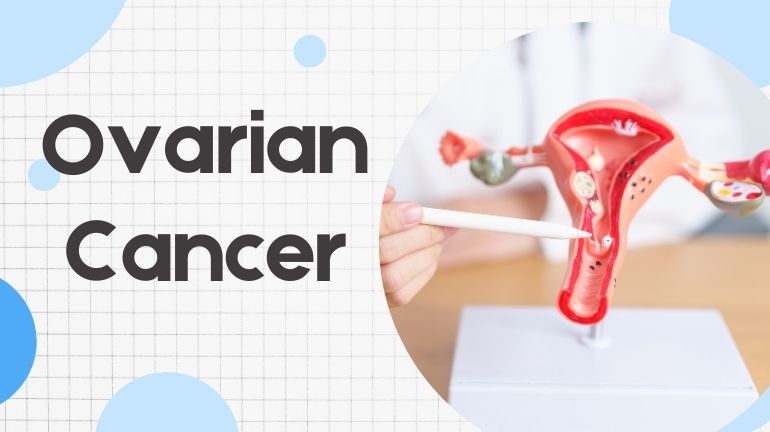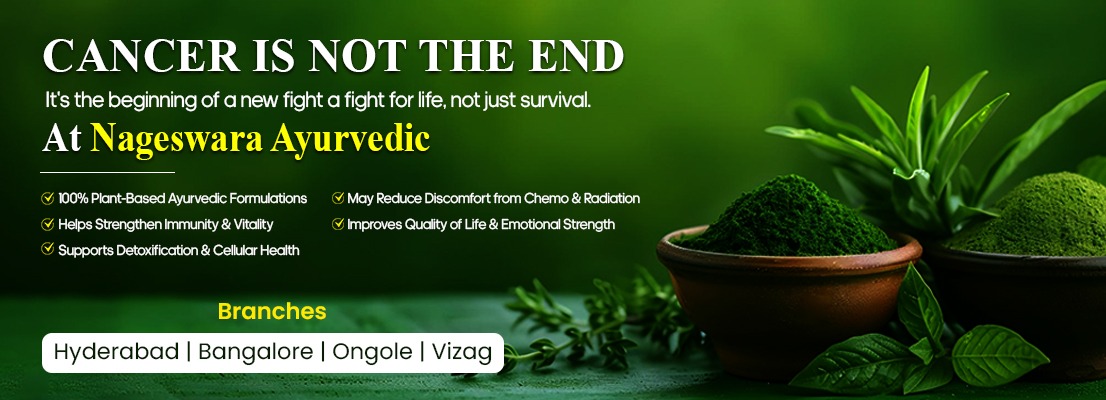
Ovarian Cancer
Ovarian cancer is a malignant tumor originating in the ovaries, the female reproductive glands responsible for producing eggs and hormones. It often develops silently and is detected in advanced stages due to vague symptoms such as bloating or abdominal discomfort. It includes epithelial ovarian carcinoma (most common), germ cell tumors, and stromal tumors. The cancer may spread to the uterus, fallopian tubes, peritoneum, and distant organs.
In Ayurveda, ovarian cancer is correlated with Artavagni Mandya (impaired metabolism of reproductive fire) and Garbhashaya Arbuda (tumor in reproductive organs) — caused by Pitta–Kapha aggravation, Ama accumulation, and Rakta–Artava dhatu dushti (impurity of blood and menstrual tissue).
Causes of Ovarian Cancer
- Genetic mutations: BRCA1 and BRCA2 gene mutations.
- Family history: Breast, uterine, or colon cancers in close relatives.
- Hormonal factors: Early menarche, late menopause, or hormone replacement therapy.
- Infertility or nulliparity: Lack of ovulation cycles balance.
- Environmental toxins: Exposure to pesticides, endocrine disruptors.
- High-fat diet and obesity.
Ayurvedic causes (Nidana):
- Suppression of natural urges (Vega Dharana).
- Irregular food habits, Viruddhahara (incompatible foods).
- Kapha and Pitta aggravating diet – excess dairy, fried foods, and mental stress.
- Weak Agni (digestive fire) leading to Ama accumulation and obstruction of Artavavaha srotas.
Types of Ovarian Cancer
- Epithelial Tumors: Originate from the surface of the ovary; most common and aggressive.
- Germ Cell Tumors: Develop from egg-producing cells; often in younger women.
- Stromal Tumors: Arise from hormone-secreting tissues; usually detected early.
- Metastatic Tumors: Spread from other organs like the breast, colon, or uterus.
Risk Factors
- Genetic predisposition (BRCA mutations).
- Age > 50 years.
- Family history of gynecological cancers.
- Hormonal imbalance or prolonged estrogen exposure.
- Obesity and sedentary lifestyle.
- Chronic inflammation and oxidative stress.
- Kapha-Pitta aggravating diet and poor elimination habits.
Signs & Symptoms
- Persistent bloating, abdominal distension.
- Pelvic or lower abdominal pain.
- Feeling full quickly or difficulty eating.
- Frequent urination or urinary urgency.
- Menstrual irregularities or postmenopausal bleeding.
- Fatigue, back pain, and unexplained weight loss.
- In advanced cases: Ascites (fluid accumulation) and breathlessness.
Complications
- Peritoneal spread and ascites.
- Intestinal obstruction due to metastasis.
- Hormonal imbalance and infertility.
- Post-surgical weakness, pain, and infection.
- Chemotherapy-induced fatigue and bone marrow suppression.
Ayurveda’s Perspective on Ovarian Cancer
Ayurveda considers ovarian cancer as Garbhashaya Arbuda – a malignant growth in the uterine–ovarian region caused by dosha imbalance (mainly Kapha and Pitta), Ama deposition, and Rakta–Artava dushti.
Nidana (Causative Factors):
- Apathyahara (unwholesome food), Viruddhahara (incompatible combinations).
- Ati Snigdha (excess oily food), Guru Ahara (heavy meals).
- Mental stress, suppression of natural urges.
- Hormonal imbalances due to disturbed Agni.
Samprapti (Pathogenesis):
- Agnimandya → Ama formation.
- Ama + Kapha–Pitta aggravation → Rakta & Artava dhatu dushti.
- Blockage of Artavavaha srotas → Granthi → Arbuda (tumor formation).
Dosha Role:
- Kapha: Cystic growth, heaviness, sluggish metabolism.
- Pitta: Inflammation, bleeding, tissue degeneration.
- Vata: Pain, dryness, and metastasis.
Ayurvedic Management Principles:
- Shodhana (Detoxification): Removal of Ama and dosha balance.
- Shamana (Pacification): Anti-inflammatory, antioxidant, and tumor-regulating herbs.
- Rasayana (Rejuvenation): Strengthening Artava dhatu, immunity, and vitality.
Ovarian Cancer Treatment at Nageswara Ayurvedic – Role of Alocasia cucullata
At Nageswara Ayurvedic, treatment for ovarian cancer follows a Rasayana-based integrative approach, emphasizing detoxification, tumor regulation, and hormonal balance using Alocasia cucullata as a core therapeutic herb.
Alocasia cucullata (Hastikanda):
- Possesses anti-tumor, anti-inflammatory, and detoxifying properties.
- Contains bioactive compounds such as alkaloids, flavonoids, and phenols, which demonstrate cytotoxic effects on cancer cells and antioxidant protection for normal tissues.
- Traditionally used in Asian medicine for tumors, cystic growths, and liver disorders, it purifies Rakta dhatu and clears srotas obstructions.
- Helps in regulating Kapha accumulation and controlling abnormal cell proliferation.
- Promotes cellular detoxification and supports ovarian tissue regeneration.
Therapeutic Actions:
- Anti-tumor: Inhibits cell proliferation and induces apoptosis.
- Anti-inflammatory: Reduces pelvic congestion and inflammation.
- Hormonal Support: Balances reproductive hormones naturally.
- Hepatoprotective: Supports liver function and detox pathways during chemotherapy.
- Rasayana Effect: Enhances Ojas, immunity, and vitality in recovering patients.
Alocasia cucullata is used along with Guduchi, Punarnava, Haridra, Shatavari, and Guggulu for synergistic Rasayana action, improving overall metabolism and strength.
Rasayana Herbs for Ovarian Cancer Care
The Rasayana formulation at Nageswara Ayurvedic includes a combination of immune-boosting, hormone-balancing, and anti-tumor herbs:
- Alocasia cucullata: Core anticancer and detoxifying agent.
- Shatavari (Asparagus racemosus): Hormonal regulator and uterine tonic.
- Guduchi (Tinospora cordifolia): Immunomodulator, detoxifier.
- Punarnava (Boerhavia diffusa): Reduces ascites and fluid accumulation.
- Haridra (Curcuma longa): Anti-inflammatory, antioxidant, cytoprotective.
- Ashwagandha (Withania somnifera): Adaptogen; improves strength and endurance.
- Amalaki (Phyllanthus emblica): Enhances antioxidant defense and vitality.
- Guggulu (Commiphora wightii): Anti-inflammatory and anti-proliferative.
These herbs work together to purify blood, restore hormonal balance, protect reproductive tissues, and improve recovery during conventional cancer treatment.
Treatment Relevance at Nageswara Ayurvedic
1. Shamana (Pacification):
Use of Alocasia cucullata, Guduchi, Haridra, Punarnava, and Guggulu to reduce tumor load, control inflammation, and restore Agni.
2. Rasayana (Rejuvenation):
Long-term Rasayana therapy with Alocasia cucullata, Shatavari, and Amalaki to enhance Ojas, rebuild reproductive tissues, and strengthen immunity.
3. Diet & Lifestyle:
Recommended: Fresh vegetables, turmeric, bitter and astringent foods, barley, millets, and green juices.
Avoid: Dairy-heavy, fried, spicy, or sugary foods; avoid day sleep and stress.
Lifestyle: Yoga (Supta Baddha Konasana, Setu Bandhasana), pranayama (Sheetali, Nadi Shodhana), and meditation for hormonal balance and mental calmness.
4. Integration with Modern Care:
Ayurvedic therapy reduces side effects of chemotherapy (fatigue, nausea, digestive weakness).
Supports liver detox, maintains energy, and prevents recurrence.
Enhances emotional well-being and long-term vitality.
